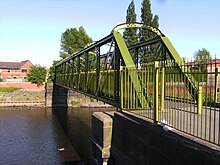Broughton Suspension Bridge
The Broughton Suspension Bridge was a chain bridge over the River Irwell between the towns of Broughton and Pendleton, now the City of Salford , Greater Manchester , England . It was one of the first suspension bridges in Europe and became famous because it collapsed on April 12, 1831, probably as a result of resonance vibrations caused by marching troops.
bridge
The bridge was built in 1826 by order of a local entrepreneur at his expense. Its execution is attributed by some to Samuel Brown , others believe that it was built by a local machine manufacturer. It was the local pride as it opened immediately after the Menai Suspension Bridge . It had a wingspan of 44 m (144½ feet ). The load-bearing chains consisted of two parallel, long iron bars, which were connected to the next two iron bars with a joint consisting of two bolts and three short flat bars. This meant that the bolts went through five bars that were close to one another and distributed the load relatively evenly on the bolts. Only the last connection consisted of a single bolt that connected the two rods of the chain with the cast iron anchor plate in the brick abutments. The chains were supported by four cast iron pylons at the ends of the bridge.
Collapse in 1831
On April 12, 1831, two groups of soldiers had already crossed the bridge without any problems when another group of around 70 soldiers in rows of four wanted to return to the barracks. The group did not march first probably in lockstep . Animated by the vibrations of the bridge, some soldiers whistled a marching song, whereupon the soldiers probably adjusted their step to the song and the vibrations, which intensified them considerably. When the head of the train had already reached the other side, there was a loud bang, whereupon one of the pylons fell into the bridge and parts of the carriageway fell about five meters into the river. About forty soldiers fell against the parts of the chain and into the water, which was very shallow at the time. There were no deaths, but around twenty were injured, including six seriously injured.
examination
The investigation showed that the pin of the last chain link with the anchor plate was broken and some other pins were bent. Because of this one broken bolt, the chain lacked an anchoring so that it outlined the pylon and caused the bridge to collapse. The vibrations caused by the soldiers had caused the break, but it was believed that sooner or later the bolt would definitely have broken. The construction of attaching the chain to the back anchor with only one bolt was criticized, and the quality of the forged bolt was questioned.
consequences
The collapse could not stop the construction of more suspension bridges, but the problem of vibrations amplified by resonance was generally consciously perceived. The British military issued a general order that troops were not allowed to march across bridges in lockstep. At Albert Bridge in London there is still a sign with the warning All troops must break step (all soldiers must march without step).
The bridge was rebuilt in a reinforced form and with chains, which were also guided twice at the rear anchoring. However, the bridge was provided with temporary supports when large crowds were expected on the bridge. This bridge was in use until 1914 when it was replaced by a steel truss bridge for pedestrians.
Web links
- Broughton Suspension Bridge Dictionary of Scottish Architects.
- John Marius Wilson, Imperial Gazetteer of England and Wales (1870-72) in Genuki (English)
- The Philosophical Magazine and Annals of Philosophy or Annals of Chemistry, Mathematics ..., Vol. IX London, 1831, p. 387 ff., Digitized on Google Books
- The Penny Cyclopaedia of the Society for the Diffusion of Useful Knowledge, Vol. XXIII London, 1842, p. 339
- Martin Braun, Differential Equations and their Applications (4 ed.), New York, Springer-Verlag. P. 175. ISBN 0-387-97894-1 . Digitized on Google Books
See also
Coordinates: 53 ° 29 ′ 46.1 ″ N , 2 ° 16 ′ 12.3 ″ W.


